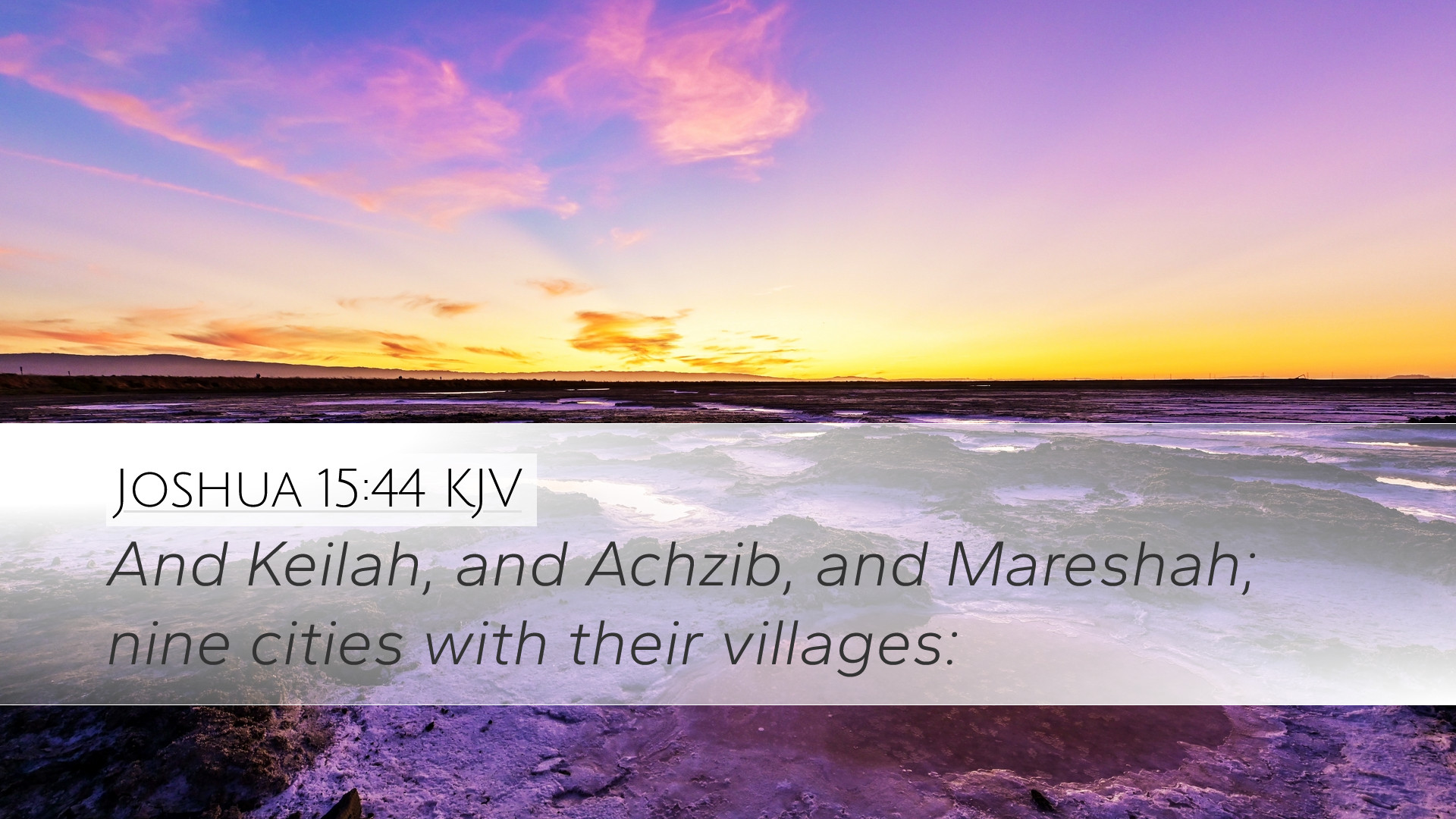Bible Commentary on Joshua 15:44
"And Ebron, and all the cities that were in the plain, and all the cities that were in the hills, and all the cities that were in the vale, and all the cities that were in the wilderness, and all the cities that were in the south, and all the cities that are in the lowland, and all the cities that are in the mountains." (Joshua 15:44)
Introduction
This verse serves as a part of the broader narrative concerning the allocation of land to the tribes of Israel, following their conquest of Canaan. It specifically highlights the territory of the tribe of Judah. In analyzing this passage, we will draw insights from public domain commentaries by Matthew Henry, Albert Barnes, and Adam Clarke to deepen our understanding of its historical, geographical, and theological significance.
Historical Context
Matthew Henry notes that this allocation of cities is not merely geographic but also reflects the fulfillment of God's promise to Abraham, Isaac, and Jacob about the land for their descendants. The cities mentioned, including Ebron, are significant both in the context of their physical location and their strategic importance during the Israelite conquests.
Albert Barnes emphasizes that Ebron is notably associated with the patriarchs and their stories. It serves as a reminder of God's promises across generations, indicating the continuity of His plan through the establishment of cities within the Promised Land.
Geographical Significance
Joshua 15:44 lists various geographical features significant to the land allocations:
- Plain: The plains often represent fertility and abundance, a theme that resonates throughout Israel's agricultural history.
- Hills: Mention of the hills underscores the diverse terrain that the Israelites had to engage with and conquer.
- Valleys: These usually symbolize challenges and trials, reflecting the spiritual and physical battles during the conquest.
- Wilderness: The wilderness denotes both the literal desolation and a place of spiritual testing that precedes fruitful living.
Adam Clarke further discusses how these geographical markers play a role in the identity of the Israelites, showing their dependence on God’s provision in various landscapes. The recognition of these diverse environments is essential for understanding the different kinds of challenges they faced.
Theological Implications
Above the mere listing of cities and geographical features, there lies profound theological significance. This passage illustrates the holistic nature of God’s promises:
- Fulfillment of Promises: Each city and region represents a promise fulfilled, reaffirming God’s covenant with His people and His faithfulness through generations.
- Divine Order: The systematic arrangement of inheritances indicates God's sovereign plan and divine order in His dealings with His people.
- Community Identity: Each city contributes to the community identity of the Israelites; it reflects how God’s people establish their presence in the land He provided.
Furthermore, as Henry points out, the city of Ebron later becomes a city of refuge, highlighting the theme of mercy and sanctuary that is echoed throughout Scripture.
Applications for Today
For contemporary readers, this verse carries multiple layers of application:
- Inheritance in Christ: As believers, we see ourselves as heirs to the promises made in Scripture. Just as Israel received its land, Christians inherit the promises of God through faith in Christ.
- Geographical and Spiritual Journeys: The varied landscapes mentioned remind us that life involves both hills and valleys, blessings and challenges. Our faith must persevere through each season.
- Community and Identity: The local church today is analogous to the cities of old, serving as a community of faith where individuals find refuge, identity, and purpose.
This emphasis on both the physical and the spiritual aspect resonates with the messages highlighted by Barnes and Clarke, encouraging believers to seek God's presence in every area of their lives.
Conclusion
In summary, Joshua 15:44 encapsulates the fulfillment of God's promises and the detailed attention He gives to His people and their needs. Through the discussions from ancient commentary, we recognize that this text is not merely a historical record but a living narrative that speaks to our present-day walk with God. The intricacies of land allocation remind us of God’s providence and the rich heritage of faith that shapes our spiritual journeys today. Each city, hill, and valley represents aspects of our own lives as we navigate our faith in light of God’s everlasting promises.


